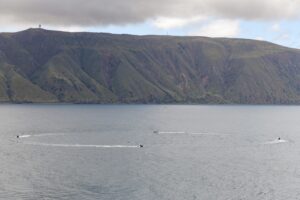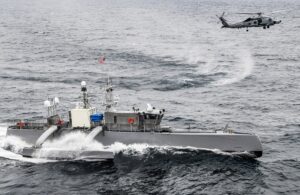The U.S. Pacific Fleet started its second multi-domain unmanned capabilities exercise on May 1, called Integrated Battle Problem 23.1.
The Unmanned Systems Integrated Battle Problem (UxS IBP) 23.1 is a tactical warfighting rehearsal event that the 3rd Fleet conducts to test and develop various fleet-centric unmanned concepts and capabilities. This includes unmanned surface vessels, undersea vessels and aerial vehicles and is starting with operations off the coast of California.

The Navy said the exercise will focus on proving the concept of “unmanned systems employment to maintain a free and open Indo-Pacific.”
UxS IBP 23.1 is specifically focused on long-range fires above and below the sea, surveillance and reconnaissance, command and control, and re-constituting intelligence, the service said.
This exercise follows the first unmanned battle problem, Unmanned Integrated Battle Problem 21 (UxS IBP21), in April 2021 (Defense Daily, April 19, 2021).
That event included a Northrop Grumman [NOC] MQ-8B Fire Scout, General Atomics MQ-9 Sea Guardian UAV, the Leidos [LDOS]-built Sea Hunter and Seahawk medium displacement unmanned surface vessels as well as other small and medium unmanned undersea vehicles with modular payloads. Notably, UxS IBP21 used unmanned systems to help forward target information to a destroyer that successfully launched and hit the target with a Standard Missile-6 weapon at beyond line of sight ranges (Defense Daily, April 27, 2021).
The previous UxS IBP included three vignettes consisting of a missile shot; intelligence, surveillance and reconnaissance work; and manned-unmanned teaming to project power. The Navy did not specify if this iteration of the event is organized in a similar manner (Defense Daily, April 20, 2021).
The Navy said this year’s participating unmanned systems include the Sea Hunter and Seahawk, AeroVironment RQ-20 PUMA unmanned aircraft system, and MARTAC T-38 Devil Ray unmanned surface vehicle.

The service said this exercise will allow U.S. Pacific Fleet and Type Commanders to evaluate the various unmanned systems and note areas for improvement to provide feedback to the unmanned programs.
However, a 3rd Fleet official underscored the unmanned systems will ultimately add to the force’s capabilities and not replace current systems.
“We view unmanned systems as a force multiplier for traditional vessels, not a replacement. We are optimizing the contribution of unmanned systems to overall naval strategy as an addition to the use of traditional vessels,” Capt. Dan Brown, Assistant Chief of Staff for Experimentation at 3rd Fleet, said in a statement.
“Successfully integrating unmanned platforms provides our commanders with better options to fight and win in contested spaces,” Brown added.
The Navy said this type of analysis, simulation, prototyping and demonstration will help it systematically field and operate systems “that possess the endurance and resilience to operate with infrequent human interaction. As a result of exercises like this, Sailors will have a high degree of confidence and skill operating alongside proven unmanned platforms at sea by the end of this decade.”